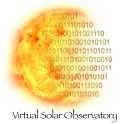| | 1 | == Spectral Range == |
| | 2 | |
| | 3 | The electromagnetic wavelength interval or equivalent over which |
| | 4 | observations are made is the fundamental discriminator among many |
| | 5 | types of solar image and other data. The model needs to apply to both |
| | 6 | narrow-band ("monochromatic" or single-line) and broad-band data. |
| | 7 | Different branches of the field use different units depending on their |
| | 8 | spectral band -- frequency at the lowest ranges (of frequency), wavelength |
| | 9 | at intermediate ranges, energy at the highest. Again for the sake of |
| | 10 | simplicity we define a single model, assuming that the necessary |
| | 11 | conversions can be simply made. |
| | 12 | |
| | 13 | |
| | 14 | |
| | 15 | ==== Wave_Type ==== |
| | 16 | |
| | 17 | |
| | 18 | type: ''menu''[[BR]] |
| | 19 | FITS keyword: ''WV_TYPE''[[BR]] |
| | 20 | |
| | 21 | The class of spectral data, relating to both the nominal spectral |
| | 22 | bandpass and the spectral target. Three values are recognized: |
| | 23 | |
| | 24 | ''' broad ''' |
| | 25 | |
| | 26 | |
| | 27 | Indicates that the spectral range of the measurement is large |
| | 28 | compared to the width of absorption/emission lines within the range, |
| | 29 | and encompasses multiple lines as well as continuum (unless blanketed) |
| | 30 | |
| | 31 | ''' line ''' |
| | 32 | |
| | 33 | |
| | 34 | The spectral range of the measurement is of the same order or less |
| | 35 | than the width of the target line, and is centered on a wavelength within |
| | 36 | the wings of the line. |
| | 37 | |
| | 38 | ''' narrow ''' |
| | 39 | |
| | 40 | |
| | 41 | The spectral range of the measurement is of the same order or less |
| | 42 | than the typical width of lines in the neighborhood, but is centered on |
| | 43 | a continuum wavelength, outside of any significant lines. This designation |
| | 44 | is used to distinguish narrow-band continuum (or "white-light") data from |
| | 45 | true broad-band data. For data of this description, the matching spectral |
| | 46 | range should be much broader than the instrumental bandpass, on the |
| | 47 | understanding that the data are proxies for broadband measurements. |
| | 48 | |
| | 49 | The exact definition of the bandpass (''e.g.'' FWHM) is not prescribed, |
| | 50 | but is left up to the terminology of the data provider. In the absence of |
| | 51 | a provider definition, FWHM should be used. |
| | 52 | |
| | 53 | |
| | 54 | ==== Wave_Minimum ==== |
| | 55 | |
| | 56 | |
| | 57 | type: ''number''[[BR]] |
| | 58 | unit: ''Ångström (10nm)''[[BR]] |
| | 59 | FITS keyword: ''WV_MIN'' |
| | 60 | |
| | 61 | ==== Wave_Maximum ==== |
| | 62 | |
| | 63 | |
| | 64 | type: ''number''[[BR]] |
| | 65 | unit: ''Ångström (10nm)''[[BR]] |
| | 66 | FITS keyword: ''WV_MAX'' |
| | 67 | |
| | 68 | The nominal minimum (maximum) of the observing spectral bandpass |
| | 69 | associated with the data. As discussed above, for narrowband continuum |
| | 70 | data, the range should be much larger than the instrumental bandpass; |
| | 71 | it should correspond to the spectral range over which the data are |
| | 72 | useful as a proxy, typically an octave or more. |
| | 73 | |
| | 74 | |
| | 75 | ==== Wave_Bands ==== |
| | 76 | |
| | 77 | |
| | 78 | type: ''number''[[BR]] |
| | 79 | FITS keyword: ''WV_NBAND''[[BR]] |
| | 80 | |
| | 81 | The number of wavelength bands in the observation |
| | 82 | |
| | 83 | |
| | 84 | ==== Wave_Step ==== |
| | 85 | |
| | 86 | |
| | 87 | type: ''number''[[BR]] |
| | 88 | unit: ''Ångström (10nm) / pixel''[[BR]] |
| | 89 | FITS keyword: ''WV_STP''[[BR]] |
| | 90 | |
| | 91 | The spectral dispersion |
